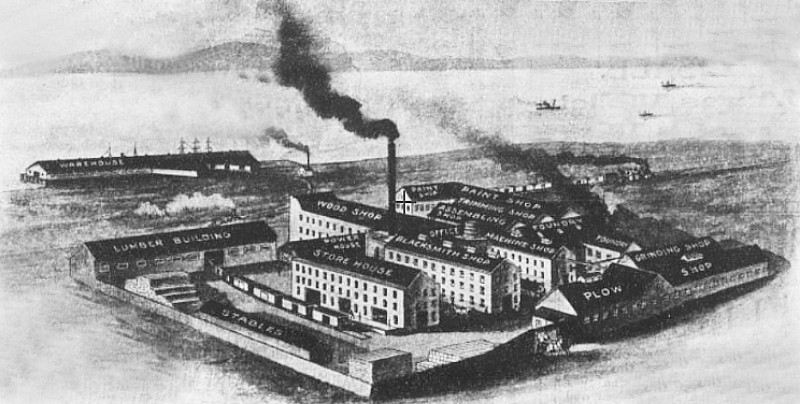
Benicia Agricultural Works ca. 1902
Baker & Hamilton, sole agents; T. B. Montgomery, superintendent and manager. This business was established in Benicia in 1880, after having been commenced several years previously in San Leandro, where it was known as the Sweepstakes Plow Works. The establishment now covers about ten acres, and has 1,000 feet of deep-water frontage, on which a wharf of 700 feet long accommodates the shipping department. The product of these works is shipped to Australia, New Zealand, Central and South American States. Sandwich Islands, Japan, China, and indeed to most points of the agricultural world, as well as to all points in California. By way of the two greatest rivers of this State, the Sacramento and San Joaquin, access is had to nearly all the agricultural portions of California. The largest ship afloat can anchor without difficulty near the great wharf of these great works, discharge its cargo and load itself with the manufactured products of this immense establishment. These works are also connected by rail with every point in the interior. The implements made here are plows, harvesting machines of every variety, the Berry steam thresher, steam traction thresher and plow, invented and first used by G. S. Berry on his large ranch in Tulare County and manufactured at these works; it is probably the largest in the world. It has a forty-two-foot cut header, in two sections,—-a fourteen-foot and a twenty-six-foot section,—-with a fifty-horsepower engine, and a twelve-horse-power stationary engine on the same frame to run separator and headers, and both taking steam from the same boiler. Mr. Berry in 1887 plowed his ground, harrowed, sowed and harvested his crop for seventy cents per acre, using a thirty-foot header. In 1888 the Benicia Agricultural Works built for him a large machine with a forty-foot header, and he reduced the expense to sixty cents per acre! He made an average of nine acres per hour during the season. In two days of ten hours each be cut 230 acres, an average of eleven and one-half acres per hour. He uses Benicia Granger plows, which he runs day and night, employing two sets of men, a locomotive light in front to see where to go, and rear lights to see the plows, enabling the men to steer the machine by night, The Berry traction is the only successful machine of the kind in use, which five years’ successful running has fully demonstrated. The price of this machine, complete, with barley crusher, is $8,500; without the crusher, $8,000, including engines, separator, headers and plows.
In the Benicia works iron farm wagons are also manufactured, and there is a special department for each specialty made and for each class of work.
Information Sources
- A Memorial and Biographical History of Northern California, 1891, pgs. 490-491